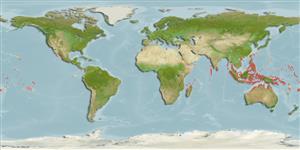Common names from other countries
>
Gobiiformes (Gobies) >
Oxudercidae (Mudskippers) > Periophthalminae
Etymology: Periophthalmus: Greek, peri = around + Greek, ophthalmos = eye (Ref. 45335).
Environment: milieu / climate zone / depth range / distribution range
Sinh thái học
Biển; Thuộc về nước lợ Cùng sống ở rạn san hô; Mức độ sâu 0 - 2 m. Tropical; 30°N - 20°S
Indo-Pacific: East Africa to Samoa.
Bộ gần gũi / Khối lượng (Trọng lượng) / Age
Maturity: Lm ? range ? - ? cm
Max length : 14.1 cm SL con đực/không giới tính; (Ref. 7050)
Các tia vây lưng cứng (tổng cộng) : 8 - 16; Các vây lưng mềm (tổng cộng) : 10 - 12; Tia cứng vây hậu môn: 1; Tia mềm vây hậu môn: 9 - 11. Differs from P. argentilineatus by lacking thin silvery bars ventrally on the sides and having pelvic fins connected at the base by a low membrane (Ref. 37816); further characterized by: frenum of pelvic fins vestigial, but visible macroscopically; pelvic fins united by membrane for about one half their length; D1 height moderate, its margin rounded, black stripe inframarginally with numerous white spots proximally, no elongate spines; D2 with single dusky stripe inframarginally; dorsal fins not connected by membrane; D1 with 11-15 spines; longitudinal scale count 66-86; head width 16.5-22.5% SL; pelvic fin length 13.1-15.4% SL; length of anal fin base 15.9-18.7% SL; length ofD2 base 18.5-23.8% SL; total D2 elements 12-13; total analfin elements 11-12; TRDB 18-22 (Ref. 5218).
Facultative air-breathing (Ref. 126274); Amphibious air-breather (Ref. 31184) that spends most of its time out of the water; able to meet its oxygen requirements as long as it stays wet. Typically resting on mud, rocks, or mangrove roots with their tails dipped in the water. Active at low tide and hunt in the intertidal zone for invertebrates; feeds on worms, crustaceans, and insects as well as polychaetes living on or near surface (Ref. 92840)
Life cycle and mating behavior
Maturities | Sự tái sinh sản | Spawnings | Egg(s) | Fecundities | Ấu trùng
Murdy, E.O., 1989. A taxonomic revision and cladistic analysis of the oxudercine gobies (Gobiidae: Oxudercinae). Rec. Aust. Mus., Suppl. 11:1-93. (Ref. 5218)
IUCN Red List Status (Ref. 130435)
CITES (Ref. 128078)
Not Evaluated
Threat to humans
Harmless
Human uses
Các nghề cá: không ích lợi (thú vị)
Các công cụ
Special reports
Download XML
Các nguồn internet
Estimates based on models
Preferred temperature (Ref.
115969): 26.1 - 29.3, mean 28.6 (based on 1953 cells).
Phylogenetic diversity index (Ref.
82804): PD
50 = 0.5000 [Uniqueness, from 0.5 = low to 2.0 = high].
Bayesian length-weight: a=0.01072 (0.00495 - 0.02318), b=2.97 (2.79 - 3.15), in cm Total Length, based on LWR estimates for this Genus-body shape (Ref.
93245).
Mức dinh dưỡng (Ref.
69278): 3.3 ±0.40 se; based on food items.
Thích nghi nhanh (Ref.
120179): Chiêù cao, thời gian nhân đôi của chủng quần tối thiểu là dưới 15 tháng (Preliminary K or Fecundity.).
Fishing Vulnerability (Ref.
59153): Low vulnerability (10 of 100).
